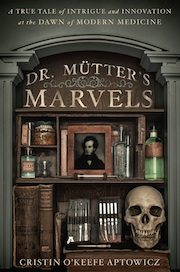
The Mütter Museum in Philadelphia has a marvelous collection of human bones, surgical specimens, monsters in jars, and medical memorabilia. It holds attractions for everyone, from the jaded medical professionals who thought they’d seen it all to the coveys of youngsters who compete to point out the grossest items to their friends, from the student of history to the connoisseur of the macabre. There is an enormous megacolon said to look like a sandworm from Dune, a plaster cast of the famous Siamese twins Chang and Eng along with their actual preserved conjoined livers, a collection of bizarre swallowed objects, an iron lung, a tumor removed from president Grover Cleveland’s jaw while he was in office, a shocking assortment of deformed fetuses…the list goes on.
I knew about the museum and greatly enjoyed visiting it, but I didn’t know anything about Dr. Mütter himself until I read a delightful new book by Cristin O’Keefe Aptowicz , Dr. Mutter’s Marvels: A True Tale of Intrigue and Innovation at the Dawn of Modern Medicine. I learned that the good doctor was every bit as marvelous as his museum, and the book took me on a fascinating trip back to the medicine of the early 1800s that made me better appreciate all that modern medicine has accomplished.
Mütter’s world
Thomas Dent Mütter was born in 1811 into a world without anesthetics, antibiotics, x-rays, or sterile precautions; a world where wide-awake patients were held down by strong men and operated on by surgeons in street clothes with ungloved hands, in rooms lit only by candles, lamps or daylight, with no pain relief other than perhaps a swig of brandy. A world where doctors operated as swiftly as possible while their patients screamed in agony, where there was little aftercare, and where wound infections were called “laudable pus” and considered an essential part of the healing process. A world where much wrong information was accepted as truth, and quackery ran rampant.
Abortion was not the controversial subject it is today, because there was no way to diagnose pregnancy before “quickening” occurred. Human life was believed to begin when the mother could feel the baby moving, not at conception.
Infection and germ theory
Infectious disease was rampant. In Philadelphia alone, with a population of around half a million, cholera killed 1,012 people in 1849, smallpox killed 427 in 1852, yellow fever 128 in 1853, scarlet fever 433 in 1852, dysentery 558 in 1852, and typhus 205 in 1848. Malaria and tuberculosis were a constant presence, and people thought of terrible illnesses as an unavoidable fact of life. The germs that caused infectious diseases had not yet been discovered, and civic leaders were only beginning to suspect there was a connection between sanitation and disease. Religious leaders spoke of poverty as the wages of sin and fought against using public money to clean up poor neighborhoods.
The germ theory of disease was still far in the future. Oliver Wendell Holmes had published a convincing paper with an analysis of cases that inescapably demonstrated that puerperal (childbed) fever was carried by doctors from patient to patient, but doctors were unwilling to admit that they were to blame. In one three-month period, 77 obstetrical patients of a single doctor contracted puerperal fever, and 15 of them died. An esteemed professor of obstetrics was brought in to investigate, and he waved off any notion that the doctor could be responsible, saying the large number of cases was only because he had such a large practice. It boiled down to the same kind of controversy we still see today, where clear scientific evidence is rejected in favor of unreliable experience and opinion. When will we ever learn?
Surgical speed and brutality
Surgeons prided themselves on the speed of their operations. One surgeon’s “joy at amputating a patient’s leg at the thigh in less than three minutes was hindered greatly when he realized he had also inadvertently sawed off the patient’s testicles.” Another managed to kill the patient, cut off his assistant’s fingers, and slash the coattails of a spectator who promptly dropped dead of fright, achieving a record surgical mortality of 300%.
Early anesthesia
In 1846, ether anesthesia was first demonstrated at Harvard. Mütter was quick to appreciate its potential and to start using it, but there was widespread opposition among his colleagues. In the early days of anesthesia the learning curve resulted in quite a few overdoses and deaths. Surgeons argued that surgery without anesthesia was less likely to kill the patient, and obstetricians cited the Bible as proof that childbirth was meant to be painful. One doctor said anesthesia was of the devil; he refused to sanction its satanic influence, and opined that “men should not be prevented from passing through what God intended them to endure!” Some even argued, without any evidence, that anesthesia would hamper the patient’s ability to heal. Aptowicz describes a hilarious incident where a professor tried to demonstrate the dangers of ether by showing that it would kill a sheep, only to have his lecture disrupted when the “dead” sheep baahed and stood up.
Patients didn’t embrace anesthesia at first either. Surgeons had once been feared as sadists who delighted in their patients’ pain, but with anesthesia there was a new perception of surgeons as ghouls who knocked you out and sliced you open in disturbing new ways while you were unable to defend yourself.
E.R. Squibb spent over a year developing and testing a new apparatus to improve the standardization of ether production; instead of patenting it, he published his research and made it available to the world for free. A surprisingly humanitarian move for a man who went on to found one of the major pharmaceutical companies. (Dare I suggest that Big Pharma is sometimes motivated by more than just profits?)
No women in medicine yet
There were no women doctors in Mütter’s world. When the Woman’s Medical College was established, the Pennsylvania Medical Society issued a scathing statement against women practitioners, saying it was offensive that they wouldn’t restrict themselves to treating other women, and that women’s nerves were too delicate for the work. The Society even went so far as to expel members who taught women doctors or consulted with them in any medical capacity.
Mütter’s surgical innovations
As a professor of surgery in Philadelphia, Mütter’s innovations and accomplishments were unprecedented; he was far ahead of his time. In early feats of plastic surgery, he repaired cleft lips, deformities from burn scars, disfiguring tumors, and other cases that most surgeons wouldn’t dream of touching. He was a major contributor to the development of skin flap techniques in plastic surgery; in one memorable case he used a flap of skin still attached to its blood supply on the patient’s back and brought it around to the front of the her neck to replace the scar tissue that had tethered her chin to her chest after a burn injury. After the operation, she was able to turn her head, close her mouth, and blink her eyes for the first time in two decades. In an era of open fireplaces, hearthside cooking, and bulky, flammable female clothing, such burn injuries were common in women. Aptowicz vividly describes the disabilities those patients endured. They were unable to show themselves in public, and they felt their lives were not worth living, so they were willing to risk death and suffer agonizing pain in experimental operations.
Mütter was not a reckless advocate of surgical intervention. He seldom agreed to operate on patients with breast cancer. Due to modesty, women usually had far advanced cancer before they sought treatment, and operating on them was only likely to cause pain, suffering, infection, and a poor quality of life while doing nothing to improve survival.
He didn’t have the advantage of germ theory, but he instinctively practiced a cleanliness that greatly reduced the risk of infection, and he instituted post-operative hospital care in an age when most patients were sent home in a carriage immediately after the operation. His bedside manner was remarkable for his era: he spent a great deal of time with patients, explaining procedures and convincing them that he truly cared for them. He criticized his peers for treating patients as cases rather than as human beings (a complaint we unfortunately still hear today). He deplored paternalism and stressed the duty of the physician to give an honest prognosis so patients could prepare for death instead of being deceived by false hope.
Although raised in the slave-holding South, he employed only free men as servants, and believed there were no biological differences between the races under the skin. He spoke out about the dangers of disunion in the days before the Civil War, which he didn’t live to see.
Mütter’s legacy
Mütter had a big impact on medicine through his students, too. Several of them fought in the Civil War. Jonathan Letterman served in the Union Army where he became the father of battlefield medicine, developed an effective Ambulance Corps, and originated the concept of triage. Robert T. Coleman became the highest-ranking medical officer in the Confederacy. Henry W. Willoughby made history by serving as assistant surgeon to the first African American troop. Others had distinguished careers, worked with Florence Nightingale in the Crimea, treated Phineas Gage (the railroad worker who survived an iron bar driven through his skull by an explosion), and contributed to legislation that improved the supply of bodies to medical schools for anatomy classes. Another, William Goodell, applied Mütter’s hygienic principles to the practice of obstetrics and was responsible for a series of 2,444 deliveries with only 6 deaths.
It’s interesting to speculate what Mütter might have gone on to accomplish had he not died at the early age of 48 after suffering for years from conditions that could have been successfully treated today (gout that crippled his hands and sometimes kept him from operating or even writing, and what may have been tuberculosis). He knew he was dying. He had become one of the country’s leading surgeons, had developed many new surgical procedures, and had educated more than a thousand young doctors; but he wanted more for his legacy. He donated his extensive collection of specimens and teaching aids to the College of Physicians of Philadelphia, where it became the basis of his eponymous museum.
I have a new hero.

